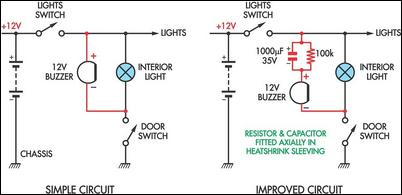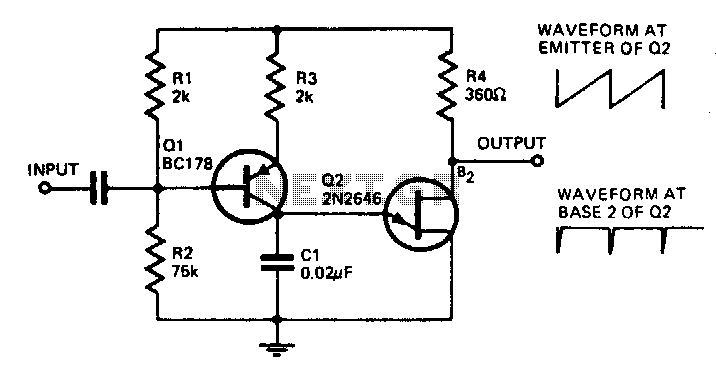
Simple Headlight Reminders

Two headlight reminder circuits are simple to install and operate based on the KISS (Keep It Simple Stupid) principle. The basic circuit consists of a 12V piezo buzzer connected between the lights circuit and a door switch. The buzzer activates if the lights are left on when a door is opened. However, a drawback of this basic circuit is that the continuous buzzing can be bothersome if the door needs to remain open while the lights are on. The enhanced circuit addresses this issue by incorporating a 1000 µF capacitor and a parallel 100kΩ resistor in series with the buzzer. In this configuration, when a door is opened, the buzzer emits a brief sound as the 1000 µF capacitor charges. The 100kΩ resistor allows the capacitor to discharge when the lights are turned off.
The headlight reminder circuit serves as an effective tool for preventing battery drain from leaving vehicle lights on inadvertently. The fundamental operation relies on a simple yet effective arrangement of a piezo buzzer, door switch, and the vehicle's lighting circuit.
In the basic configuration, the piezo buzzer is connected in such a way that it activates when the door switch closes, indicating that the door has been opened. The buzzer generates an audible alert to remind the user that the vehicle's lights are still on. This straightforward design adheres to the KISS principle, ensuring ease of installation and operation.
However, to enhance user experience, an improved circuit design has been proposed. The addition of a 1000 µF capacitor and a 100kΩ resistor significantly alters the behavior of the buzzer. Upon opening the door, the capacitor begins to charge, creating a brief sound from the buzzer rather than a continuous alarm. This modification is particularly useful in scenarios where the door may need to be left open for an extended period, such as during loading or unloading of cargo.
The 100kΩ resistor plays a crucial role in the circuit's functionality. It provides a discharge path for the capacitor when the vehicle's lights are turned off, allowing the circuit to reset and ensuring that the buzzer will only sound again if the door is opened while the lights remain on. This design effectively balances the need for an alert system with user comfort, preventing the annoyance of a continuous alarm while still providing a critical reminder function.
Overall, this headlight reminder circuit exemplifies an efficient solution to a common automotive issue, combining simplicity with enhanced functionality through thoughtful circuit design.These two headlight reminder circuits are easy to install and operate on the KISS (Keep It Simple Stupid) principle. The simple circuit involves adding just a 12V piezo buzzer between the lights circuit and a door switch.
The buzzer sounds if the lights are left on and you open a door. The disadvantage of this simple circuit is that it`s annoying to have the buzzer sound continuously if you want to leave the door open while the lights are on. The improved circuit overcomes that problem by adding a 1000 µF capacitor and a parallel 100kO resistor in series with the buzzer. Now, when a door is opened, the buzzer gives a brief burst of sound only, while the 1000 µF capacitor charges.
The 100kO resistor discharges the capacitor when the lights are switched off. 🔗 External reference
The headlight reminder circuit serves as an effective tool for preventing battery drain from leaving vehicle lights on inadvertently. The fundamental operation relies on a simple yet effective arrangement of a piezo buzzer, door switch, and the vehicle's lighting circuit.
In the basic configuration, the piezo buzzer is connected in such a way that it activates when the door switch closes, indicating that the door has been opened. The buzzer generates an audible alert to remind the user that the vehicle's lights are still on. This straightforward design adheres to the KISS principle, ensuring ease of installation and operation.
However, to enhance user experience, an improved circuit design has been proposed. The addition of a 1000 µF capacitor and a 100kΩ resistor significantly alters the behavior of the buzzer. Upon opening the door, the capacitor begins to charge, creating a brief sound from the buzzer rather than a continuous alarm. This modification is particularly useful in scenarios where the door may need to be left open for an extended period, such as during loading or unloading of cargo.
The 100kΩ resistor plays a crucial role in the circuit's functionality. It provides a discharge path for the capacitor when the vehicle's lights are turned off, allowing the circuit to reset and ensuring that the buzzer will only sound again if the door is opened while the lights remain on. This design effectively balances the need for an alert system with user comfort, preventing the annoyance of a continuous alarm while still providing a critical reminder function.
Overall, this headlight reminder circuit exemplifies an efficient solution to a common automotive issue, combining simplicity with enhanced functionality through thoughtful circuit design.These two headlight reminder circuits are easy to install and operate on the KISS (Keep It Simple Stupid) principle. The simple circuit involves adding just a 12V piezo buzzer between the lights circuit and a door switch.
The buzzer sounds if the lights are left on and you open a door. The disadvantage of this simple circuit is that it`s annoying to have the buzzer sound continuously if you want to leave the door open while the lights are on. The improved circuit overcomes that problem by adding a 1000 µF capacitor and a parallel 100kO resistor in series with the buzzer. Now, when a door is opened, the buzzer gives a brief burst of sound only, while the 1000 µF capacitor charges.
The 100kO resistor discharges the capacitor when the lights are switched off. 🔗 External reference





